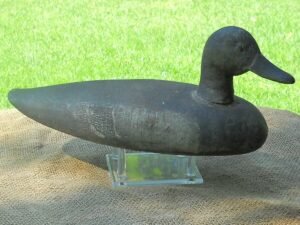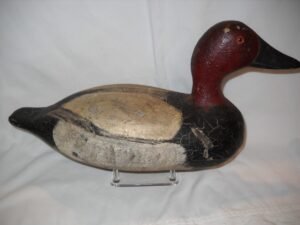A Decoy Corner Article
By Bruce Urben, WWA President
All photos courtesy Wisconsin Sporting Collectibles

Lake Winnebago in the late 1800’s was a hotbed for migrating waterfowl and, it seems, also a hotbed for sportsmen who hunted and carved decoys for use on “the bago”. Some carved thousands of decoys, others carved just what they needed to put food on the table for their families. This article is about one of the latter, a consummate sportsman, hunter, fisherman, trapper and decoy carver.
Louis J. Stark was born in Appleton, WI, in 1876. His parents were Prussian immigrants who came to America for a better life. Louis grew up in the Appleton area and held various odd jobs until he married in 1903 and began steady employment as a local postal worker. Stark hunted, fished and trapped on the Fox River near Appleton and waterfowl hunted Lake Winnebago and the chain of lakes from Partridge Lake, Poygan, Butte des Morts and Rush lake. He waterfowl hunted through the 1930’s and eventually retired on the western shore of Lake Winnebago in a small cottage just south of Neenah. Louis lived there until his death in 1942.

During Stark’s waterfowling era, he carved upwards of one hundred decoys, mainly for his own use, including mallards, bluebills, canvasbacks and a few teal. His decoy bodies were made from discarded telephone poles and his heads were made from pine or cedar. Louis would saw the poles to decoy length and then chopped them into rough shape using an axe. It wasn’t until the early 1930’s that he acquired a bandsaw! He finished his decoys with draw knives, spokeshaves, hand knives and a bow sander. He used white lead to fill in the neck cracks and cracks in the body and hand mixed his own oil paint. His paint was mixed by using dry, ground pigment with white lead, turpentine and linseed oils. This provided a waterproof seal and a beautiful patina to his decoys. He feathered his decoys by dipping a rolled piece of burlap and patting the thickened paint on the decoy body. It has been reported that Louis experimented with various painting techniques, including wet on wet and wet on dry applications.

Louis poured his own weights and keels by melting discarded lead water pipe. Louis, like other carvers from that era, were quite frugal and used what was available.
Louis Stark’s decoy output might have been limited, but his craftsmanship was outstanding. Examples of his decoys today have stood the test of time and are beautiful pieces of working, “floating art”. As you might expect, his decoys are highly valued by collectors and because of his limited output are also quite scarce!
Louis J. Stark, the consummate Lake Winnebago Sportsman and Decoy carver. Another true Wisconsin Original Decoy Carver.
